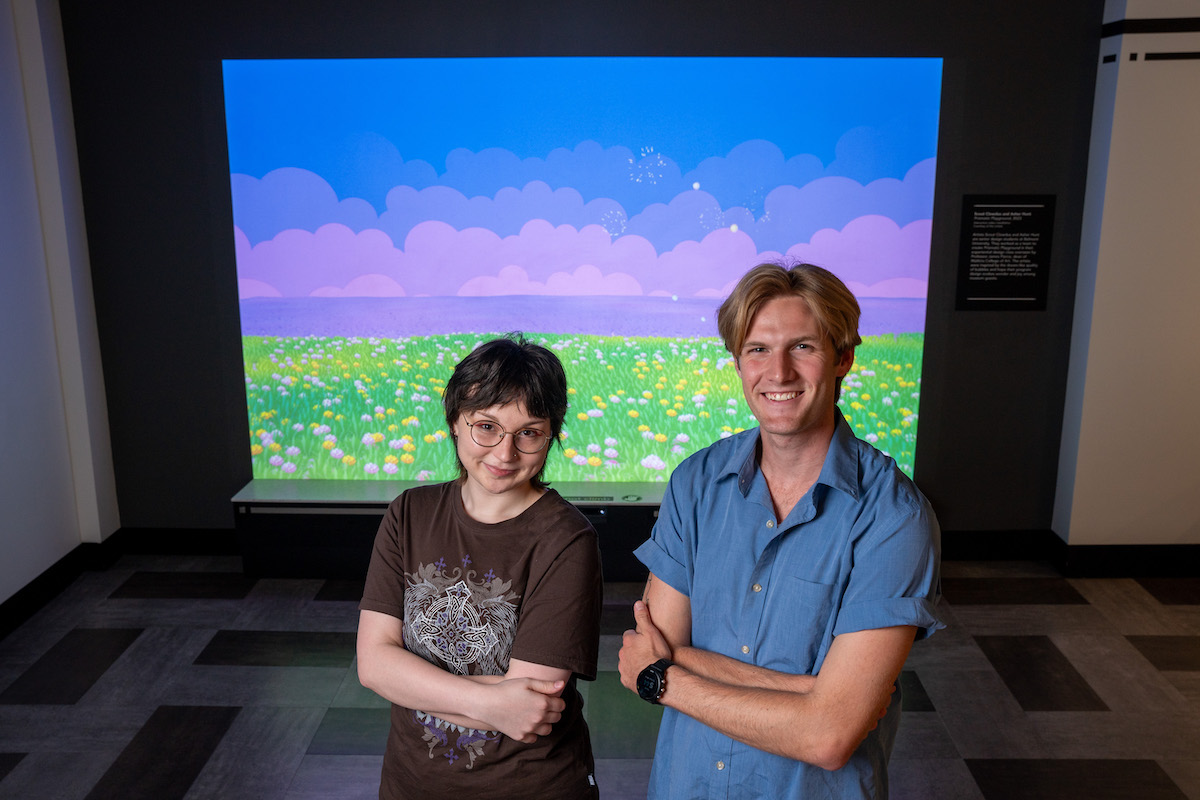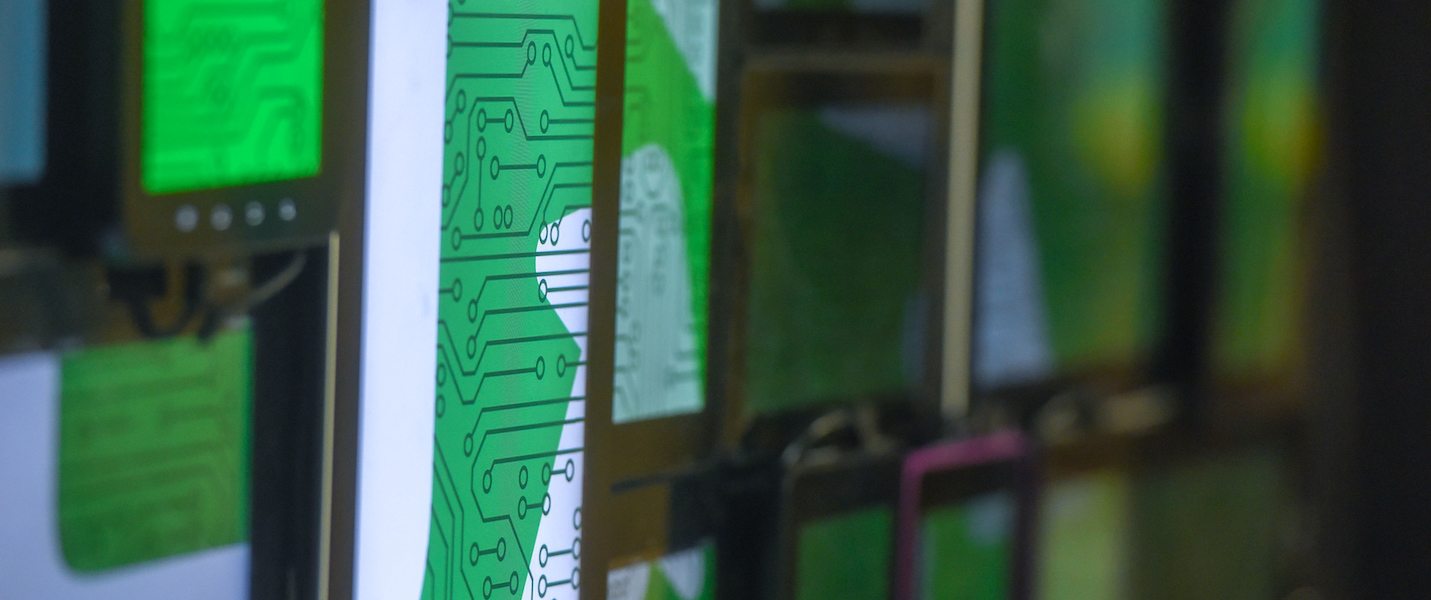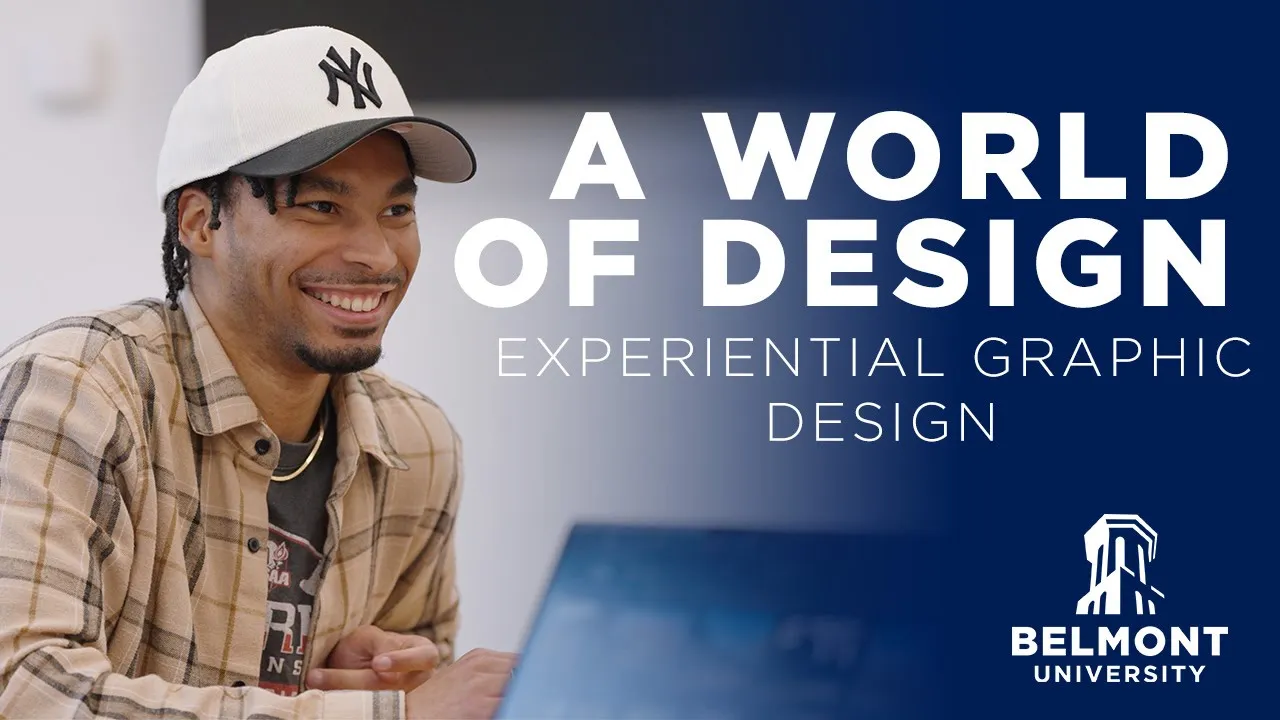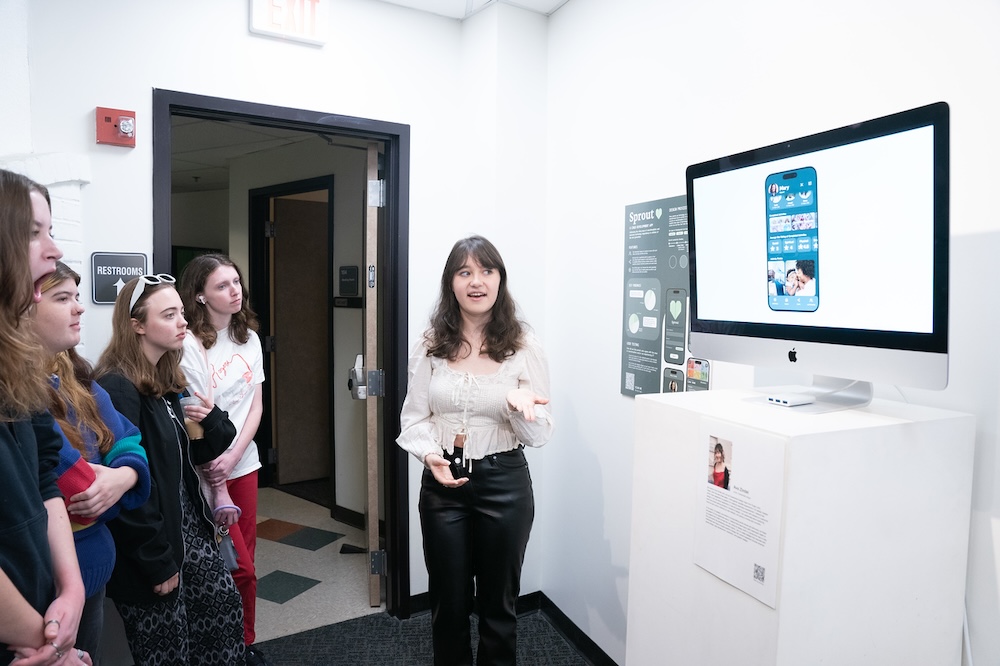Why Major in Experiential Design?
 Watkins College of Art's Experiential Design B.F.A. major focuses on human-centered design interactions. The program engages students—on both the technical and conceptual levels—through hands-on learning with individual attention from professors.
Watkins College of Art's Experiential Design B.F.A. major focuses on human-centered design interactions. The program engages students—on both the technical and conceptual levels—through hands-on learning with individual attention from professors.
Program focus:
- Designer’s social responsibility
- Designing for public spaces
- Commercial applications for experiential design.
The Experiential Design major builds on the first two years of the core Design Communication (graphic design) courses. Starting at the junior level, you will begin exploring interaction and user experience design in both digital and non-digital environments. At the senior level, you will refine your knowledge of various experiences and user interaction design techniques.
Throughout the program, you will be introduced to web design, motion graphics, kinetic typography and storyboarding. Emphasis is also placed on typography and design history to give a historical context of design and its relationship to culture.
Our program puts you in the heart of Nashville, a fast-growing center of the design and technology industry.
Program Details
The Experiential Design major leads to a bachelor of fine arts. It requires 128 hours of coursework.
BELL Core requirements: 38 hours
Art Foundation: 15 hours
Major requirements: 70 hours
General electives: 3 hours
Courses You'll Take
- ART 1060, Introduction to Darkroom Photography
An introduction to the basics of black and white photography. This class emphasizes the basic parts and operation of an SLR (manual) camera, black-and-white film processing and darkroom use. Students will study the basics of composition, design, lighting, printing, processing and final print presentation. Students will learn to develop film, process prints and other printing controls such as dodging, burning, split filtering, experimental printing techniques and the use of filters. The concentration is on photography as a fine art medium. Students must have a 35mm manual control camera.
- ART 1100, Introduction to Digital Photography
This is a beginning-level class, starting at and expanding on the basics of DSLR color exposure, processing in Camera RAW, Bridge and Photoshop as well as the basics of using the scanner as a means of photographic capture. This class will cover the basics of photographic color theory, composition fundamentals in photography and the applications of color in photography. There will be a strong emphasis on developing the ability to communicate ideas effectively through the photographic medium as well as the ability to talk about photographic works analytically, formally and conceptually. Concentration is on photography as a fine are medium.
- ART 1700, Principles of Web Page Design
This course is an integrated introduction to web page design, covering both its aesthetic and technical aspects. The topics introduced will include: Internet Protocol fundamentals, HTML, page layout, imaging, color, typography, embedded technologies, file types, portability and performance.
- ART 2025, Digital as Designed Object
This course will assist students in nurturing the ability to efficiently translate ideas and concepts into digitally produced physical objects. We will consider digital fabrication and its role in the localization and production of goods and explore its impact on the commodification of the art object. Through a series of technical demonstrations, students will make connections between computer-aided design, digital fabrication technologies and the physical world. Students will complete a series of projects exploring 3D modeling, 3D printing, CNC milling and laser cutting.
- ART 2410, Introduction to Design Principles
Design is the use of visual forms (words and images) that are used to convey information to diverse audiences. This course is the first in a sequence of Design Communications courses. Students will explore the use of basic design principles, design elements, introductory theory and brainstorming techniques to solve basic communication problems without the use of a computer. Emphasis will be on observation, analysis, design process, terminology, creative thinking, problem-solving, execution and craftsmanship. Several projects may be considered as portfolio pieces.
- ART 2420, Design Systems
One in a series of Design Communications courses that focuses on the development of a professional-level design portfolio. Projects include multiple-piece design, introduction to product identity, and an introduction to three-dimensional graphic design. The course also emphasizes raster imaging and covers compositing of graphic elements in advanced page-layout applications. Extensive outside work is required.
- ART 2430, Typography: Layout
A studio course covering the history, terminology and use of typography in the design communications industry. Students will use traditional and computer-based typographic tools to complete exercises and problems. Projects and exercises will range from the examination of the interaction of individual letterforms to organization of text in publication layouts. Students will practice a variety of typographic philosophies.
- ART 2431, Typography: Form
A studio course covering the history, terminology and use of typography in the design communications industry. Students will use traditional and computer-based typographic tools to complete exercises and problems. Projects and exercises will range from the examination and creation of individual symbol glyphs to their use in complex communications. Emphasis will be placed on the development of a professional-level typeface specimen.
- ART 2432, Typography: Kinetic
Students explore design and typographic concepts in motion media. Students build sequential design and motion within a time-based media environment as they explore storytelling and continuity. A combination of photography, graphic images, type, sound and video is used to create sequences and animated shorts. The course builds on the development of interactivity for web and mobile devices utilizing interactive and video embedding capabilities in HTML5, animation using CSS3 transitions and jQuery/JavaScript.
- ART 2450, Interactive Media
This is an introduction to Interactive Media. Topics include animation, scripting and delivery of vector-based interactive media. Emphasis is on web-based media applications. Applications used include Photoshop, Dreamweaver and Illustrator. The course will emphasize the software application Adobe Flash and JavaScript.
- ART 2452, Introduction to Visual Scripting
Intro to Visual Scripting will introduce students to creating and manipulating visual design through the use of industry-standard scripting languages, such as JavaScript. The course will explore the commercial and artistic value of creating responsive visual designs through programmatic methods.
- ART 2460, Introduction to Motion Graphics
Introduction to Motion Graphics focuses on time-based design elements of space, pacing, motion and interaction as they relate to graphic communication. This course uses motion graphics and web technologies as strategic mediums for experimentation and communication, while introduction some of the software and techniques for creating motion and interactive work. It provides an overview of After Effects, starting with an introduction to the use interface and the basic tool set. It continues on to cover the fundamentals of animating within the software. Students learn to add effects to graphic elements and video, creating titles and sophisticated motion. Rotoscoping, keying and motion tracking are also covered. The course introduces interactivity for web and mobile devices utilizing interactive and video embedding capabilities in HTML5, animation using CSS3 transitions, and some jQuery/JavaScript.
- ART 2462, Visualization & Storyboarding
Visualization and storyboarding provides an introduction into concept development and the visual expression of those ideas in narratives intended for time-based media. Students are taught to produce motion media storyboards and animatics using the tools and techniques of traditional and digital media. Continuity style is emphasized. The content is relevant for animation and live-action film and video.
- ART 2800, World Art - Pre-Modern
This course offers an introductory overview of visual art, material objects and architecture representing cultures from around the world beginning in the era of Prehistory to ca. 1300. Visual analysis of forms, techniques, styles, subjects and symbolism is grounded in an understanding of related historical contexts and societal beliefs.
- ART 2810, World Art - Early &Modern
This course explores visual art and architecture across many cultures and geographies from the early modern period to the present day. Visual analysis of forms, techniques, styles, subjects and symbolism frame global narratives and cross-cultural connections within a chronological overview.
- ART 3440, History and Philosophy of Design
Students will examine the history and relevant theory of visual communication and graphic design including its historical relationship to the larger culture in which it functions. In viewing graphic design beyond the aesthetic, emphasis will be placed on its role in areas such as commerce, culture, propaganda, ideology and the social/political arenas. The underlying themes will be technological influence on communication and the evolution of visual form and language. This lecture course combines readings, discussions and practical application of theory/concepts through written assignments and possible creation of visual artifacts.
- ART 3451, Human-Computer Interaction
This course focuses on information architecture, user interaction and usability within web-based environments. Students learn the process of design of interaction for graphic-user-interface applications, web design and everyday objects.
- ART 3510, Experiential Design Studio I
Experiential Design Studio I is the first in a sequence of courses for the Experiential Design major exploring new and immersive technologies. This course focuses on the theory, methodology and history behind the design, development and interpretation of experiential media systems. Students will be introduced to HTML5, CSS3, JavaScript and supporting software and hardware technologies to display and interact with finished projects.
- ART 3520, Experiential Design Studio II
Experiential Design Studio II continues the processes and exploration for creating compelling human-centered experiences through design and technology. Students will have an opportunity to use design processes from multiple disciplines to develop real-world solutions. This course focuses on the further implementation of theory and methodology behind the design and development of experiential designs. Students will continue to explore HTML5, CSS3, JavaScript and supporting software and hardware technologies to display and interact with finished projects.
- ART 4510, Experiential Design: Interactive Narrative
This course will allow the students to use technology to communicate ideas to a wider audience. The underlying theme will be narrative (linear and non-linear) as we investigate the designer’s role and responsibility within society through interactive and shared experiences. Students will address philanthropic and socio-technical issues and will be encouraged to explore new ways of thinking about engaging with design. Students will incorporate software and hardware technologies to create, display and interact with finished projects.
- ART 4520, Experiential Design: Design for Public Space
Students will create and critique a variety of interactive projects for gallery exhibitions, advertisements and socio-cultural issues designed for public spaces. Students are expected to show technical competence, aesthetic knowledge and theoretical relevance. Students will incorporate a variety of integrated media systems to create, display and interact with finished projects.
- ART 4900, Senior Exhibition / Portfolio
This course is for all graduating art majors. The objective is to develop the skills and impart the information necessary for being a working artist or designer, culminating in an exit review in the form of a formal portfolio review for Design Communications majors and a gallery exhibition for Studio and Art Education majors. Design Communications majors may also have a gallery exhibition. Students will develop a resume, business card and promotional material and gain first-hand experience working with printers and other professional resources. Students will focus and get advice on the formal development-planning, preparation, execution- of their portfolio or exhibit. In addition, career-oriented discussions in a seminar atmosphere will relate to concerns and issues in the professional art and design world including but not limited to graduate school, job searches, networking as well as visits to area galleries, studios and design firms. Upon the completion of the course, students are required to submit a slide portfolio and copies of their printed collateral (resume, business card and self-promotional piece) in addition to their exit portfolio/exhibit.
- CSC 1110, Programming I
An introduction to computer organization, algorithm development and programming.
- ART 2490, Design Empathy
With the advancement in technology and changing needs of people, designers are challenged to look for innovative approaches to cater for the needs of their users toward an effective/positive user experience. As a result it is important to gain a deeper understanding of a uniquely identified targeted audience - empathy. Through projects and case studies, students will learn the importance of designing for perspectives other than their own. Topics will include human-centered design process; diversity, inclusion and equity; and critical thinking.
- ART 2850, Portfolio Practices
Through inquiry, reflection and integration, students will bring coherence to, synthesize and integrate learning experiences inside and outside of the classroom in the context of a liberal arts university by producing an electronic portfolio for both academic and professional purposes. This course will introduce students to the basis of documenting, curating, reflecting on and showcasing learned proficiency as shown through such artifacts as visual and written work. The course will emphasize both visual and written/reflective components of creating and critique. Students will also be introduced to professional practices in preparation for an internship.
Internships
All students pursuing a B.F.A. degree must complete at least one internship for college credit. Students may work in any art or design-related employment, such as advertising, publishing or galleries. Students can earn up to 6 credits towards their degree.
- Study abroad (Semester, Maymester, or Summer)
- Study away for a semester in alternate markets through Belmont USA (N.Y.C., L.A., Washington D.C.)
- Internships- Our relationship to Nashville’s professional creative community is personal and rich. We will assist you with internship placement to ensure the experience is a good fit.
- Four campus gallery spaces to professionally exhibit your work
- Opportunities to present at campus-wide research symposiums and professional conferences
- Kappa Pi, an international honorary art fraternity
- Watkins students are consistently juried into local, regional, and national competitions, including: AAF Student ADDY Awards and Graphics New Talent Annual
We encourage you to explore the exceptional work our students create in their programs.
The Watkins College of Art requires all students applying for a Bachelor of Fine Arts (BFA) degree to submit a portfolio as a part of the admissions process. You must first be admitted to Belmont before hearing a decision from Watkins.
Portfolios submitted before December 1 will be considered for the Watkins Merit Scholarships. Any applications submitted after December 1 will be considered for admission, but not for departmental scholarships.
View all Portfolio Guidelines
Deadlines for the Portfolio and Belmont application:
December 1 for scholarship consideration
April 1 for incoming freshmen students
June 1 for incoming transfer students
What if I am accepted to Belmont but not the BFA program?
Any applicants not accepted into a BFA program will have the option to be enrolled in a second major of their choice. We encourage applicants to select one of our Bachelor of Arts majors (Art Studies, Art History, or Photographic Studies). At the end of the student’s freshman year and completion of foundational courses, the student will be eligible to reapply to the BFA program through another portfolio review.
The Watkins College of Art has significant scholarship opportunities for students. Last year, the college offered more than 55 scholarships to incoming students valuing over $380,000.
Applicants who intend to pursue a degree in the Watkins College of Art and wish to be considered for the merit-based scholarship must submit a portfolio of work in art and/or design. Students must have their Belmont application and portfolio submitted by December 1 to be eligible for the scholarships.
Please visit the Portfolio Guidelines page for more specific details.
Need-based scholarships will be determined from a student's Free Application for Federal Student Aid (FAFSA). This is the official form that families use to apply for college financial assistance from the federal government.
In addition to Belmont University's Southern Association of Colleges and Schools Commission on Colleges (SACSCOC) accreditation, the Watkins College of Art is a fully accredited institutional member of the National Association of Schools of Art and Design (NASAD).
A Closer Look
What sets experiential design apart from traditional art and design programs?
A student exhibition of experiential design projects in the Leu Center for the Visual Arts exemplifies the compelling storytelling work that emerges from Watkins' distinctive program.

Real World Opportunities
Our experiential design students' immersive installations "Prismatic Playground" & "Color Theory" are creating multi-sensory art experiences at the Frist Art Museum in Nashville!
These captivating pieces were born from a class competition challenging students to design accessible, interactive installations for the museum's transformative media space.
Career Possibilities
- User Experience (UX) and User Interface (UI) Designer
- Graphic Designer
- Application/App Development
- Augmented or Virtual Reality
- Gaming and Entertainment Industry
- Projection-Mapping
- Display and Kiosk Design
- Wayfinding Systems
- Advertising and Marketing
What You'll Learn
- Interactive Design
- Projection-Mapping
- Product Development
- Design for Public Spaces
- App Design
- Web Design Including UX & UI
- Augmented & Virtual Reality (AR and VR)
- Other Emerging Technologies





